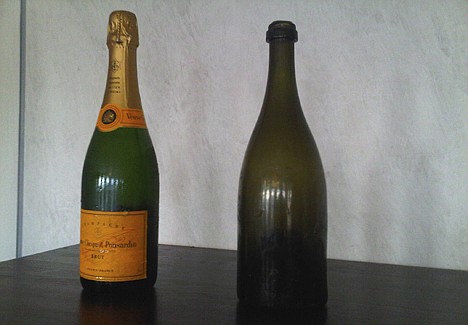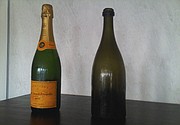After 200 years, this champagne still tasty
MARIEHAMN, Finland (AP) - Here's what nearly 200-year-old champagne salvaged from the bottom of the sea tasted like to wine experts: lime blossoms, coffee, chanterelles.
Here's what it tasted like to me: yeast, honey and - dare I say it? - a hint of manure.
The antique bubbly wasn't very bubbly after its long sleep in the cold and murky Baltic Sea. But I couldn't help feeling a thrill Wednesday as I took a sip of history captured in that cloudy, golden liquid.
After all, I was drinking what could be the world's oldest champagne. And some of the unopened bottles that are to be auctioned might go for as much as $70,000 apiece.
The shipwreck was discovered in July near the Aland Islands - a wind-swept archipelago between Sweden and Finland - by a group of divers. Researchers say the ship was probably en route from northern Germany to the west coast of Finland with its prestigious cargo when it sank, sometime in the first half of the 1800s.
Connoisseurs haven't been able to date precisely the 168 bottles raised from the shipwreck. All they can say is they are from the early 19th century and astonishingly well-preserved.
I was among 20 people invited to the tasting in Mariehamn, the capital of the island group. After a presentation of the diving operation, an archaeologist wearing white gloves presented two bottles to champagne specialist Richard Juhlin - a Veuve Clicquot and a Juglar, a now-defunct champagne house.
Juhlin sampled both in front of journalists.
"Great! Wonderful!" he exclaimed. Then he paused, soaking in the flavors.
"What strikes you the most is that it's such an intense aroma," he continued. "It's so different from anything you've tasted before."
He found hues of chanterelles, honey, orange and peach in the Juglar; linden blossoms and lime peels in the Veuve Clicquot.
We were given a choice to sample either the Veuve Clicquot or the Juglar.
Easy, I thought. I'll go for the Juglar, since that brand doesn't exist anymore.
I raised a wine glass containing about an inch (a few centimeters) of Champagne, which contained tiny pieces of cork but very little fizz. A mushroomy-yeasty flavor soon gave way to sweet notes of honey - much like a sugary dessert wine.
That's not unexpected - Champagne in the 19th century was a lot sweeter than it is today.
A standard bottle of Champagne now has about 9 grams of sugar, said Stephane Gerschel, a spokesman for Veuve Clicquot, founded in 1772. In the 1830s, the house used more than 100 grams of sugar per bottle - and even that wasn't sweet enough for some.
"In Russia, the trend was to serve Champagne with a spoonful of sugar," Gerschel said.
Tastes have changed dramatically since then, and some contemporary Champagnes are lauded for their bone-dry finish.
And what about that hint of manure? Well, it doesn't necessarily put me among the Philistines, since some experts find whiffs of cat urine in some French whites.
As for its lack of bubbles, Champagne loses its fizz over time as minute amounts of gas gradually pass through the porous cork. In this case, most of the gas was probably lost due to pressure changes when the divers raised the bottles, Juhlin said.
At least three of the 11 opened bottles from the Baltic wreckage have been identified as Veuve Clicquot "with absolute certainty," the company said.
The bottles don't have labels but experts said they could tell they were Veuve Clicquot by the branding of the corks, which featured a comet - added to pay tribute to one that crossed the skies of Champagne in 1811 "and was rumored to be the cause of a harvest of remarkable quality."
"All bottles are not intact but the majority are in good condition," said Britt Lundeberg, Aland's culture minister.
Some of the bottles will be sold by the Aland government, which owns them, at an auction, where Juhlin said they could fetch more than $70,000 apiece.
Those bottles that are not expected to last may be mixed with newer Champagne to create a fresh blend. The government will keep five bottles as archaeological artifacts.
Champagne house Perrier-Jouet, a subsidiary of Pernod Ricard, has said that its vintage from 1825 is the oldest recorded Champagne in existence.
Essi Avellan, editor of Fine Champagne Magazine, said after tasting the Juglar that it resembled the old Perrier-Jouet.
"It's quite sweet, it's very velvety, and has a round smoothness. But perfectly fresh still," she said. "I've also tasted the 1825 in Champagne and it's quite in line with the sweetness level."
The Veuve Clicquot had "a toasted, zesty nose with hints of coffee, and a very agreeable taste with accents of flowers and lime tree," said Francois Hautekeur of the company's winemaking team.
Experts were amazed at how well-preserved the Champagne was. The reason is the Baltic Sea offers perfect storage conditions: The temperature is constantly around 41 degrees Fahrenheit (5 degrees Celsius), there is total darkness, and the water pressure is similar to what's inside the bottle, said Veuve Clicquot's Gerschel.
He believes the taste is very close to what it was when the Champagne was bottled.
"It's like a time machine," he said. "We think it's exceptional that it's not only drinkable but that it still has some fizz, after 200 years."



